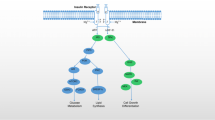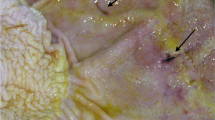Abstract
Epidemiological studies have reported an association between high iron (Fe) levels and elevated risk of developing type 2 diabetes mellitus (T2D). It is believed that the formation of Fe-catalyzed hydroxyl radicals may contribute to the development of diabetes. Our goal was to determine the effect of a diet with a high Fe content on type 2 diabetic pigs. Four groups of piglets were studied: (1) control group, basal diet; (2) Fe group, basal diet with 3,000 ppm ferrous sulfate; (3) diabetic group (streptozotocin-induced type 2 diabetes) with basal diet; (4) diabetic/Fe group, diabetic animals/3,000 ppm ferrous sulfate. For 2 months, biochemical and hematological parameters were evaluated. Tissue samples of liver and duodenum were obtained to determine mRNA relative abundance of DMT1, ferroportin (Fpn), ferritin (Fn), hepcidin (Hpc), and transferrin receptor by qRT-PCR. Fe group presented increased levels of hematological (erythrocytes, hematocrit, and hemoglobin) and iron parameters. Diabetic/Fe group showed similar behavior as Fe group but in lesser extent. The relative abundance of different genes in the four study groups yielded a different expression pattern. DMT1 showed a lower expression in the two iron groups compared with control and diabetic animals, and Hpc showed an increased on its expression in Fe and diabetic/Fe groups. Diabetic/Fe group presents greater expression of Fn and Fpn. These results suggest that there is an interaction between Fe nutrition, inflammation, and oxidative stress in the diabetes development.



Similar content being viewed by others
References
Puntarulo S (2005) Review: iron, oxidative stress and human health. Mol Asp Med 26:299–312
Dymock IW, Cassar J, Pyke DA, Oakley WG, Williams R (1972) Observations on the pathogenesis, complications and treatment of diabetes in 115 cases of haemochromatosis. Am J Med 52(2):203–210
Niederau C, Fischer R, Purschel A, Stremmel W, Haussinger D, Strohmeyer G (1996) Long-term survival in patients with hereditary hemochromatosis. Gastroenterology 110(4):1107–1119
Feder JN, Gnirke A, Thomas W, Tsuchihashi Z, Ruddy DA, Basava A (1996) A novel MHC class I-like gene is mutated in patients with hereditary haemochromatosis. Nat Genet 13:399–408
Zhou XY, Tomatsu S, Fleming RE, Parkkila S, Waheed A, Jiang J, Fei Y, Brunt EM, Ruddy DA, Prass CE, Schatzman RC, O'Neill R, Britton RS, Bacon BR, Sly WS (1998) HFE gene knockout produces mouse model of hereditary hemochromatosis. Proc Natl Acad Sci U S A 95(5):2492–2497
Witte D, Crosby W, Edwards C, Fairbanks V, Mitros F (1996) Practice guideline development task force of the college of American pathologists. Hereditary Hemochromatosis. Clin Chim Acta 245:139–200
Fernández-Real JM, López-Bermejo A, Ricart W (2005) Iron stores, blood donations, and insulin sensitivity and secretion. Clin Chem 51(7):1201–1205
Fernández-Real JM, Peñarroja G, Castro A, García-Bragado F, Hernández-Aguado I, Ricart W (2002) Blood letting in high-ferritin type 2 diabetes: effects on insulin sensitivity and beta-cell function. Diabetes 51(4):1000–1004
Salonen J, Tuomainen TP, Nyyssônen K, Lakka HM, Punnonen K (1998) Relation between iron stores and non-insulin dependent diabetes in men: case–control study. BMJ 317(7160):727
Jiang R, Manson J, Meigs J, Ma J, Rifai N, Hu F (2004) Body iron stores in relation to risk of type-2 diabetes in apparently healthy women. JAMA 291(6):711–717
Jiang R, Ma J, Ascherio A, Stampfer M, Willett W, Hu F (2004) Dietary iron intake and blood donations in relation to risk of type-2 diabetes in men: a prospective cohort study. Am J Clin Nutr 79:70–75
Shi Z, Hu X, Yuan PX, Meyer H, Holmboe-Ottesen G (2006) Association between serum ferritin, hemoglobin, iron intake, and diabetes in adults in Jiangsu, China. Diabetes Care 29(8):1878–1883
Choi SW, Benzie IF, Ma SW, Strain JJ, Hannigan SW (2008) Acute hyperglycemia and oxidative stress: direct cause and effect? Free Radic Biol Med 44:1217–1231
Ferrannini E (2000) Insulin resistance, iron, and the liver. Lancet 355:2181–2182
Green A, Basile R, Rumberger JM (2006) Transferrin and iron induce insulin resistance of glucose transport in adipocytes. Metabolism 55:1042–1045
Tuomainen TP, Nyyssonen K, Salonen R, Tervahauta A, Korpela H, Lakka T, Kaplan GA, Salonen JT (1997) Body iron stores are associated with serum insulin and blood glucose concentrations. Population study in 1013 eastern Finnish men. Diabetes Care 20:426–428
Rajpathak S, Crandall JP, Wylie-Rossett J, Kabbat GJ, Rohan TE, Hu FB (2009) The role of iron in type-2 diabetes. Biochim Byophys Acta 1790:671–681
Wilson JG, Lindquist JH, Grambow SC, Crook ED, Maher JF (2003) Potential role of increased iron stores in diabetes. Am J Med Sci 325:332–339
Furugouri K (1972) Effect of elevated dietary levels of iron on iron store in liver, some blood constituents and phosphorus deficiency in young swine. J Anim Sci 34:573–577
Hansen S, Trakooljul N, Liu HC, Moeser A, Spears J (2009) Iron transporters are differentially regulated by dietary iron, and modifications are associated with changes in manganese metabolism in young pigs. J Nutr 139(8):1474–1479
Hansen S, Trakooljul N, Spears J, Liu HC (2010) Age and dietary iron affect expression of genes involved in iron acquisition and homeostasis in young pigs. J Nutr 140:271–277
Koopmans S, Mroz Z, Dekker R, Corbijn H, Ackermans M, Sauerwein H (2006) Association of insulin resistance with hyperglycemia in streptozotocin-diabetic pigs: effects of metformin at isoenergetic feeding in a type-2-like diabetic pig model. Metab Clin Exp 55(7):960–971
Pfaffl MW (2001) A new mathematical model for relative quantification in real-time RT-PCR. Nucleic Acids Res 29(9):e45
Dixon J, Stoops J, Parker J, Laughlin M, Weisman G, Sturek M (1999) Dyslipidemia and vascular dysfunction in diabetic pigs fed an atherogenic diet. Arterioscler Thromb Vasc Biol 19(12):2981–2992
Gunshin H, Mackenzie B, Berger U, Gunshin Y, Romero M, Boron W, Nussberger S, Gollan J, Hediger M (1997) Cloning and characterization of a mammalian proton-coupled metal-iron transporter. Nature 388:482–488
Yeh KY, Yeh M, Watkins JA, Rodriguez-Paris J, Glass J (2000) Dietary iron induces rapid changes in rat intestinal divalent metal transporter expression. Am J Physiol Gastrointest Liver Physiol 279(5):G1070–G1079
Gunshin H, Allerson CR, Polycarpou-Schwarz M, Rofts A, Rogers JT, Kishi F, Hentze MW, Rouault TA, Andrews NC, Hediger MA (2001) Iron-dependent regulation of the divalent metal ion transporter. FEBS Lett 509(2):309–316
Garrick MD, Dolan KG, Horbinski C, Ghio AJ, Higgins D, Porubcin M, Moore EG, Hainsworth LN, Umbreit JN, Conrad ME, Feng L, Lis A, Roth JA, Singleton S, Garrick LM (2003) DMT1: a mammalian transporter for multiple metals. Biometals 16(1):41–54
Herbison CE, Thorstensen K, Chua AC, Graham RM, Leedman P, Olynyk JK, Trinder D (2009) The role of transferrin receptor 1 and 2 in transferrin-bound iron uptake in human hepatoma cells. Am J Physiol Cell Physiol 297(6):C1567–C1575
Silva M, de Brito Magalhães CL, de Paula Oliveira R, Silva ME, Pedrosa ML (2012) Differential expression of iron metabolism proteins in diabetic and diabetic iron-supplemented rat liver. J Biochem Mol Toxicol 26(3):123–129
Hentze MW, Rouault TA, Caughman SW, Dancis A, Harford JB, Klausner RD (1987) A cis-acting element is necessary and sufficient for translational regulation of human ferritin expression in response to iron. Proc Natl Acad Sci USA 84(19):6730–6734
Han J, Day JR, Connor JR, Beard JL (2002) H and L ferritin subunit mRNA expression differs in brains of control and iron-deficient rats. J Nutr 132(9):2769–2774
Wang W, Knovich MA, Coffman LG, Torti FM, Torti SV (2010) Serum ferritin: past, present and future. Biochim Biophys Acta 1800(8):760–769
Rogers JT (1996) Ferritin translation by interleukin-1and interleukin-6: the role of sequences upstream of the start codons of the heavy and light subunit genes. Blood 87(6):2525–2537
Smirnov IM, Bailey K, Flowers CH, Garrigues NW, Wesselius LJ (1991) Effects of TNF-alpha and IL-1beta on iron metabolism by A549 cells and influence on cytotoxicity. Am J Physiol 277(2 Pt 1):L257–L263
Kalantar-Zadeh K, Kalantar-Zadeh K, Lee GH (2006) The fascinating but deceptive ferritin: to measure it or not to measure it in chronic kidney disease? Clin J Am Soc Nephrol 1(Suppl):S9–S18
Torti FM, Torti SV (2002) Regulation of ferritin genes and protein. Blood 99(10):3505–3516
Pang JH, Jiang MJ, Chen YL, Wang FW, Wang DL, Chu SH, Chau LY (1996) Increased ferritin gene expression in atherosclerotic lesions. J Clin Investig 97(10):2204–2212
Heller RA, Schena M, Chai A, Shalon D, Bedilion T, Gilmore J, Woolley DE, Davis RW (1997) Discovery and analysis of inflammatory disease-related genes using cDNA microarrays. Proc Natl Acad Sci USA 94(6):2150–2155
Watt R (2011) The many faces of the octahedral ferritin protein. Biometals 24:489–500
Mena NP, Esparza A, Tapia V, Valdés P, Núñez MT (2008) Hepcidin inhibits apical iron uptake in intestinal cells. Am J Physiol Gastrointest Liver Physiol 294(1):G192–G198
Ganz T (2003) Hepcidin, a key regulator of iron metabolism and mediator of anemia of inflammation. Blood 102(3):783–788
Nemeth E, Rivera S, Gabayan V, Keller C, Taudorf S, Pedersen BK, Ganz T (2004) IL-6 mediates hypoferremia of inflammation by inducing the synthesis of the iron regulatory hormone hepcidin. J Clin Investig 113(9):1271–1276
Jiang F, Sun ZZ, Tang YT, Xu C, Jiao XY (2011) Hepcidin expression and iron parameters change in type 2 diabetic patients. Diabetes Res Clin Pract 93(1):43–48
Kulaksiz H, Theilig F, Bachmann S, Gehrke SG, Rost D, Janetzko A, Cetin Y, Stremmel W (2005) The iron-regulatory peptide hormone hepcidin: expression and cellular localization in the mammalian kidney. J Endocrinol 184(2):361–370
Kulaksiz H, Fein E, Redecker P, Stremmel W, Adler G, Cetin Y (2008) Pancreatic beta-cells express hepcidin, an iron-uptake regulatory peptide. J Endocrinol 197(2):241–249
Frazier MD, Mamo LB, Ghio AJ, Turi JL (2011) Hepcidin expression in human airway epithelial cells is regulated by interferon-γ. Respir Res 12:100
Ganz T, Nemeth E (2012) Hepcidin and iron homeostasis. Biochim Biophys Acta 1823(9):1434–1443
Chung B, Chaston T, Marks J, Srai SK, Sharp PA (2009) Hepcidin decreases iron transporter expression in vivo in mouse duodenum and spleen and in vitro in THP 1 macrophages and intestinal Caco-2 cells. J Nutr 139(8):1457–1462
Khan ZA, Barbin YP, Cukiernik M, Adams PC, Chakrabarti S (2004) Heme-oxygenase-mediated iron accumulation in the liver. Can J Physiol Pharmacol 82(7):448–456
Acknowledgments
We thank Angelica Letelier and Amaya Oyarzún for technical assistance, and Maureen Middleton for helping with care and management of animals. This project was funded in part by (1) Comisión Nacional de Investigación Científica y Tecnológica (CONICYT)—Scholarship for Doctoral Thesis 2010; (2) Programa de Investigación Domeyko en Salud, Universidad de Chile—Scholarship Doctoral Thesis 2010; and (3) FONDECYT Grant 1110080 to MA
Author information
Authors and Affiliations
Corresponding author
Rights and permissions
About this article
Cite this article
Espinoza, A., Morales, S. & Arredondo, M. Effects of Acute Dietary Iron Overload in Pigs (Sus scrofa) with Induced Type 2 Diabetes Mellitus. Biol Trace Elem Res 158, 342–352 (2014). https://doi.org/10.1007/s12011-014-9944-4
Received:
Accepted:
Published:
Issue Date:
DOI: https://doi.org/10.1007/s12011-014-9944-4




